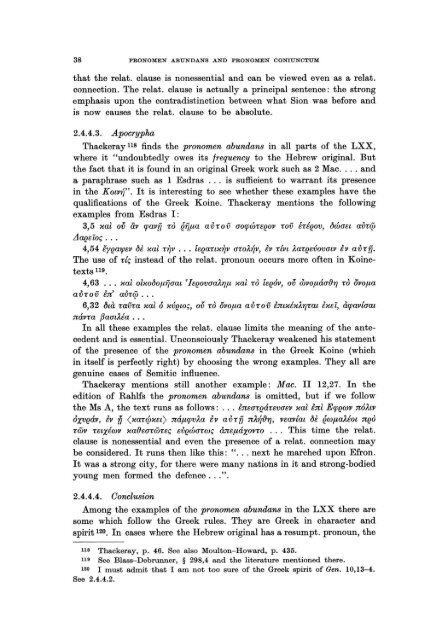Pronomen Abundans and Pronomen Coniunctum. A ... - DWC
Pronomen Abundans and Pronomen Coniunctum. A ... - DWC
Pronomen Abundans and Pronomen Coniunctum. A ... - DWC
You also want an ePaper? Increase the reach of your titles
YUMPU automatically turns print PDFs into web optimized ePapers that Google loves.
38 PRONOMEN ABUNDANS AND PRONOMEN CONIUNCTUM<br />
that the relat. clause is nonessential <strong>and</strong> can be viewed even as arelat.<br />
connection. The relat. clause is actually a principal sentence: the strong<br />
emphasis upon the contradistinction between what Sion was before <strong>and</strong><br />
is now causes the relat. clause to be absolute.<br />
2.4.4.3. Apocrypha<br />
Thackeray 118 finds the pronomen abundans in all parts of the LXX,<br />
where it "undoubtedly owes its frequency to the Hebrew original. But<br />
the fact that it is found in an original Greek work such as 2 Mac .... <strong>and</strong><br />
a paraphrase such as 1 Esdras . . . is sufficient to warrant its presence<br />
in the Kotv~".<br />
It is interesting to see whether these examples have the<br />
qualifications of the Greek Koine. Thackeray mentions the following<br />
examples from Esdras I:<br />
3,5 xat ov av q;avfj ro éfjfla a1rrov aoq;áJTeeov rov ÉtÉeov, bwaet avr0<br />
Llaeeioç ...<br />
4,54 l!yeatpev bi xat r~v ... [eeaTlx~v aroA~v, Èv rtVl Aareevovaw Èv avrfj.<br />
The use of rtç instead of the relat. pronoun occurs more of ten in Koinetexts<br />
119.<br />
4,63 ... xat olxoboflfjaal 'leeoVaaA.-YJfl xat ro [ee6v, OV WVOfláafhJ ro ovofla<br />
avrov Èn' avr0 ...<br />
6,32 blà mvm xat ó xvewç, ov ro ovofla avrov È'nlXéxA'YJml Èxei, àq;avtaat<br />
návm {3aatÄÉa ...<br />
In all these examples the relat. clause limits the meaning of the antecedent<br />
<strong>and</strong> is essential. Unconsciously Thackeray weakened his statement<br />
of the presence of the pronomen abundans in the Greek Koine (which<br />
in itself is perfectly right) by choosing the wrong examples. They all are<br />
genuine cases of Semitic infiuence.<br />
Thackeray mentions still another example: Mac. II 12,27. In the<br />
edition of Rahlfs the pronomen abundans is omitted, but if we follow<br />
the Ms A, the text runs as follows: ... Èneareárevaev xat Ènt Eq;ewv n6ALV<br />
oxveáv, Èv fJ ( xauf>xel) náwpvAa Èv avrfj nA~fh;, veavtal bi éWflaÄÉol neo<br />
u.óv relxéwv xafharwreç evewarwç ànefláxovro ... This time the relat.<br />
clause is nonessential <strong>and</strong> even the presence of arelat. connection may<br />
be considered. It runs then like this: "... next he marched upon Efron.<br />
It was a strong city, for there were many nations in it <strong>and</strong> strong-bodied<br />
young men formed the defence . . .".<br />
2.4.4.4. Conclusion<br />
Among the examples of the pronomen abundans in the LXX there are<br />
some which follow the Greek rules. They are Greek in character <strong>and</strong><br />
spirit 120. In cases where the Hebrew original has a resumpt. pronoun, the<br />
118 Thackeray, p. 46. See also Mouiton-Howard, p. 435.<br />
119 See Blass-Debrunner, § 298,4 <strong>and</strong> the literature mentioned there.<br />
120 I must admit that I am not too gure of the Greek spirit of Gen. 10,13-4.<br />
See 2.4.4.2.
















